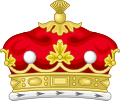| Marquessate of Abergavenny | |
|---|---|
  Arms: Gules, a saltire argent charged with a rose of the field barbed and seeded proper. Crest: Out of a Ducal Coronet Or, a Bull's Head proper, charged with a Rose Gules. Supporters: On either side a Bull Argent, pied Sable, armed unguled collared and chained Or, the latter terminating in a Staple Or | |
| Creation date | 14 January 1876 |
| Created by | Queen Victoria |
| Peerage | Peerage of the United Kingdom |
| First holder | William Nevill, 5th Earl of Abergavenny |
| Present holder | Christopher Nevill, 6th Marquess of Abergavenny |
| Heir apparent | None |
| Remainder to | the 1st Marquess's heirs male of the body lawfully begotten. |
| Subsidiary titles |
|
| Status | Extant |
| Seat(s) | Eridge Park |
| Former seat(s) | |
| Motto | Ne vile velis (Wish not wickedly) |
Marquess of Abergavenny (pronounced Abergenny[ citation needed ]) in the County of Monmouth, is a title in the Peerage of the United Kingdom created on 14 January 1876, along with the title Earl of Lewes (pronounced "Lewis"), in the County of Sussex, [1] for the 5th Earl of Abergavenny, a member of the Nevill family.
Contents
- History
- Medieval origins
- Subsidiary titles
- Coat of arms
- Earl of Abergavenny (1784)
- Marquess of Abergavenny (1876)
- Family tree and line of succession
- See also
- References
- Sources
The 6th and present Marquess is Christopher George Charles Nevill (b. 23 April 1955), son of Lord Rupert Nevill and Lady Anne Camilla Evelyn Wallop. He succeeded to the title in 2000 on the death of his uncle the 5th Marquess, who had no surviving sons.
The family seat is Eridge Park, near Royal Tunbridge Wells, Kent.

